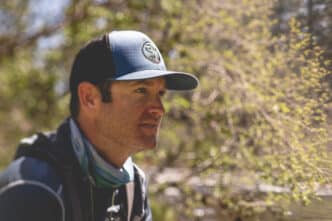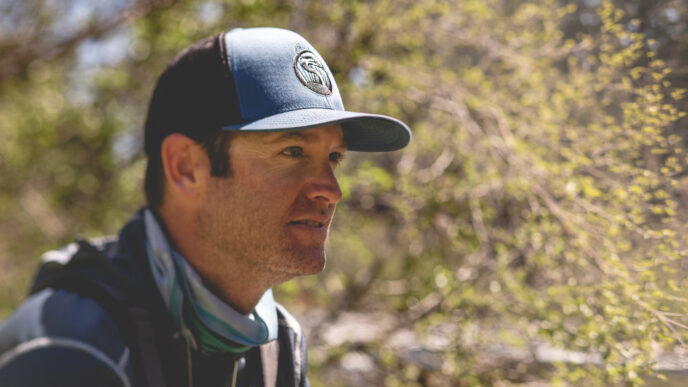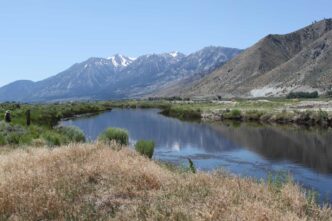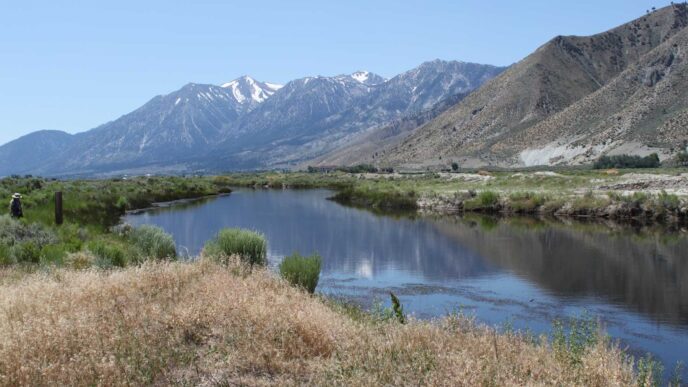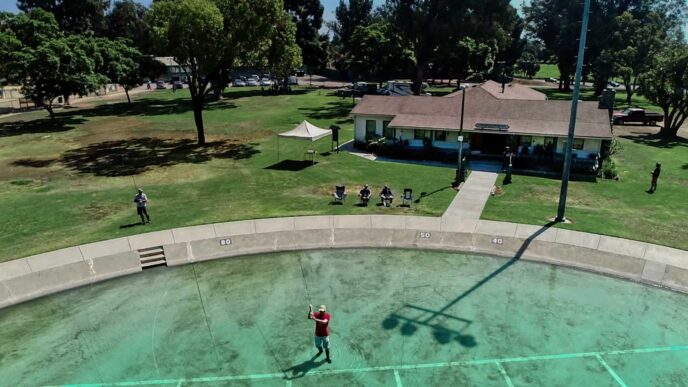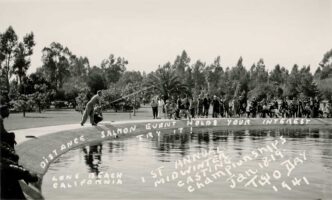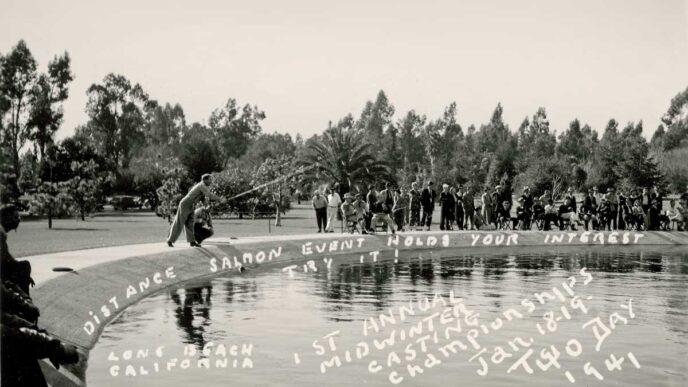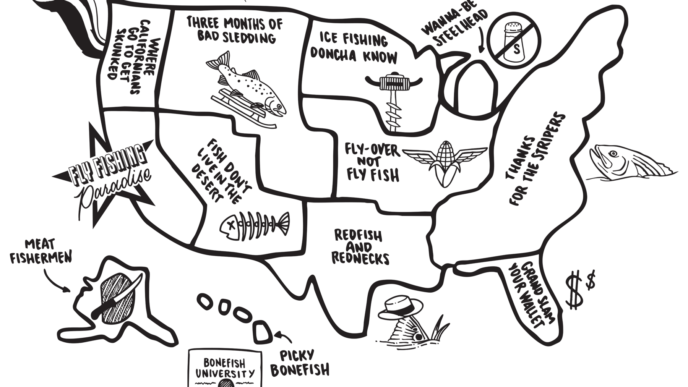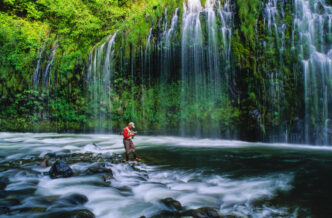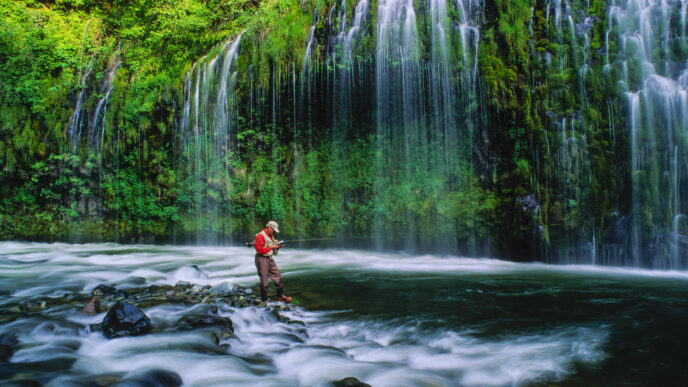I became a steelhead fanatic by chance some years ago, when I rented a place in Alexander Valley. The realtor called it a “mobile home,” but that was gilding the lily. It was a beat-up trailer on a hillside above the Russian River. I could almost cast a line from the deck to a good pool down below. As an experienced trout angler, I assumed I’d be picking up steelies in no time, but that was naïve and utterly laughable.
I’d moved to the valley to live cheaply. I hoped to write a book, but the river kept pulling me away from my desk. I did my homework and bought the right gear at the tackle shop in Healdsburg. At great personal cost, I listened to the old-timers at John & Zeke’s Bar reminisce about a golden age when they’d taken eighty steelies in a season. As I struggled to hook my first one, I cursed them for being so greedy. I never added up the hours I spent before that miracle happened, but trust me, it was a lot.
Steelhead don’t come easily in Northern California anymore, although they did when sport first took hold in the 1880s. The Russian, the Eel, the Van Duzen, all the coastal rivers were full of anadromous rainbows. When four anglers from San Francisco traveled to the Eel in October 1897, the editors at the Ferndale Enterprise thought it newsworthy and carried a report. Just reaching the river proved to be an ordeal for the gents. They’d likely have gone by rail to Sherman, then boarded a stagecoach to Dyerville at the confluence of the South Fork and main Eel, a two-day journey.
The most popular hostelry was Gregg’s Resort, a little north of Fortuna. It offered a tavern, a dining room, and lodging. A wide veranda overlooked Gregg’s Pool on the Eel (later known as the Fernbridge Hole), where a Mrs. Van Zandt tied flies to order. She could copy any common pattern, but invented her own flies as well. Her husband had helped to establish the Sand Bar Club, whose members insisted that any man should take his fish on the fly and leave bait fishing to the women and children.
For the city gents, the Eel fished like never before. The water was lower than in other years, and they caught half-pounders, mature steelhead, and salmon, some to twenty pounds. During the sunny part of the day they used lures, switching to flies after three o’clock. One member of the party, a Mr. Gallagher, returned to San Francisco with sixty pounds of fish, all caught in a single day. But the most proficient fly fisher by far was an Irishman, John S. Benn, who became a legendary angler and fly tyer.
Benn hailed from County Cork, where his family owned a prosperous mill. Trained as a millwright, he put his skills to work when he emigrated to California in 1855. Although he was only in his late teens, he developed a serious case of rheumatism that caused him to go blind twice and left him barely able to walk for seven years. Unable to meet the demands of his job, he chose a more sedentary occupation and set up a fly-tying business in San Francisco with his daughter, Martha, as his partner.

In the early days of steelhead flies, Benn became an acknowledged master. His patterns were a staple for anglers on the north coast. They included Benn’s Coachman, a riff on the Royal Coachman; the Martha, named after his daughter; the Soule, a type of Parmacheene Belle with an extra jungle cock; and the Railbird or Humboldt Railbird, a fly still in use. He was such a celebrity that the Enterprise heralded his arrival in Eureka in 1903, “J.S. Benn, the noted expert fly maker . . . will try some of his own materials in attempting to lure the finny denizens of the Eel River . . .”
Shortly before Benn’s seventieth birthday, the San Francisco Call ran a profile of him. An illustration showed the old man at his vise with specs on his nose and a pipe in his mouth. “He is stalwart and bright,” wrote the reporter, “with no ailments left for his old age, and fond of his jokes.” Martha worked at her own vise nearby, leaving the reporter slightly breathless as he described how “his gaze wandered from her even white teeth to her deep brown eyes and coal black hair.” He wouldn’t get away with it these days.
Free of his rheumatism, Benn had fished “in various parts of the world, from the San Juan River in South America to the turbulent streams of the British Isles.” He ordered his special scissors from Paris, small and of the finest steel. He bought “woodcock wings from Japan, jungle cock from India, grouse and partridge from the heaths of Scotland, and golden pheasant from China.” It had been two years since Benn’s last fishing trip, and he had no plans for the next one.
“It would be hard to estimate how many fish have gone afoul of Benn’s flies,” the reporter concluded. The old master died not long after the profile appeared, but Martha kept the business going.
The Russian River was producing good catches too by the 1900s. Louis Gotthelf had the “high hook” at the start of the 1910 season, or so the Call announced. He’d “negotiated 14 pounds of fighting steelhead” on his first day in Duncans Mills on the lower river, and “creeled a 20-pounder a few days later.” Such big-league hauls were unusual in my time, although I could count on King’s Sport and Tackle in Guerneville to list a few of the trophy fish I could only dream of hooking.
As my obsession grew, I fished almost daily when the stream was in shape, every morning or evening. If I heard the steelies were on the move, I fished both shifts with only a short break for lunch. In spite of my diligence, it would be three weeks or so before I finally landed a steelhead. It pains me to admit I caught it on a salmon roe “berry” a friend had given me. He couldn’t stand to see me suffer any longer, he said. His gift led me to a 7-pound buck, who took the bait so ferociously the rod nearly tore from my hand.
“I’d had so little luck on the Russian I expected to be skunked again, so I reacted slowly when I felt my fly stop toward the end of its drift.”
I soon corrected the error of my ways. I had no interest in being lumped together with the women and children of the Sand Bar Club, so I switched back to flies only. That wasn’t an easy decision to make. If the river was high or silty, fly fishing might be honorable, but it was seldom very successful. At times I was tempted to backslide if I saw other anglers scoring with bait, but I stuck with flies until I earned my just reward.
It was a day in November, not long before Thanksgiving. I walked and waded a quarter-mile from my home stretch of the stream, blind casting a leech pattern to pools and riffles that looked promising. I’d had so little luck on the Russian I expected to be skunked again, so I reacted slowly when I felt my fly stop toward the end of its drift. The take was very delicate, but I woke up when I set the hook. The fish woke up, too, and fought for twenty long minutes before I brought it to net, silvery and fresh-run and dotted with sea lice.
I stayed five years in Alexander Valley, and my skills continued to improve. I caught and released ten or twelve steelies a season, give or take. The best fly fishing was in the spring, when the river dropped and cleared and the smaller fish called bluebacks showed up to spawn. They were particularly eager and rose readily to a dry.
When I listened to the old-timers at John & Zeke’s I never realized I’d be an old-timer myself someday, recalling a golden age when Healdsburg had no wineries, Warm Springs Dam hadn’t been built, and the steelhead were often wild and always beautiful.





